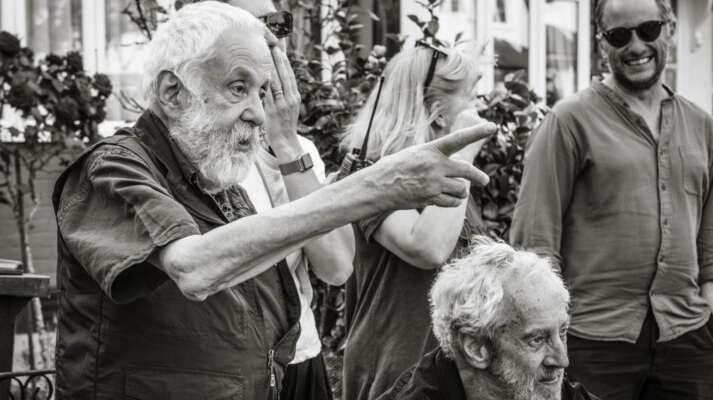Unlikely Alliances
The emotional power unleashed by unexpected friendships in Papillion and other films.
Unlikely Alliances
Written by Peter Bowen
At the heart of Michael Noer's Papillon is the complex relationship between safecracker Henri "Papillon" Charrière (Charlie Hunnam) and currency forger Louis Dega (Rami Malek). While on the boat to Devil's Island, convicted prisoner Papillion identifies the meek, terrified Dega as a possible way out of his predicament. Their relationship starts as a simple business transaction: Papillon will defend the frail Dega as long as he provides funds (from the money he has hidden on his body) to help Papillon escape. Over time their mercenary agreement morphs into something unexpected. In casting Hunnam and Malek, the filmmakers sought to recreate on set the dramatic tension that exists between their characters. "One of the coolest things about Charlie and Rami is the way they push and pull at each other," explains producer Joey McFarland, adding, "In some ways they're true polar opposites, and that's what helped their relationship grow into what you see in the film."
For the filmmakers, getting the right chemistry began with finding the right actors. For the title character, "Charlie ticked all the boxes," explained McFarland. Throughout his career, Hunnam has defined a sort of fearlessness in the characters he's played. From the outlaw motorcycle gang leader in the TV show Sons of Anarchy to the intrepid explorer Percy Fawcett in The Lost City of Z, Hunnam embodies men, like Papillon, who insist on living by their own rules no matter the cost. For Dega, they needed an actor who would convey a complex interior life and contrast-and ultimately complete-Papillon's rough demeanor. Perhaps best known for his Emmy-winning performance as Mr. Robot's Elliot Alderson, the security engineer who is an expert at shielding the many layers of his paranoid personality, Malek is an actor of endless depth. In a series of roles, from the closeted best friend in the sitcom The War at Home to a suicide bomber on 24 to the emotionally unhinged soldier in the HBO miniseries The Pacific to his upcoming role as Freddie Mercury in Bohemian Rhapsody, Malek has perfected the art of playing men who keep an essential part of themselves hidden away. Malek's inscrutable expression and mysterious eyes speak volumes by refusing to give us his secrets. Malek, who loved the book as a kid, saw the adventure in how these two men transformed each other. "Essentially, it's a story about understanding one's true self," explains Malek. "These two unlikely friends become so reliant on each other that a genuine love evolves between them. And that love allows them to understand not only the other person, but themselves as well." Like other great films about unlikely characters coming together, Papillon explores the power of that love.

Midnight Cowboy | A different island prison
Where Papillon had Devil's Island, Midnight Cowboy had the isle of Manhattan, both places where its disenfranchised characters have to bond to survive. When John Schlesinger's Midnight Cowboy hit theaters in 1969, audiences hardly knew how to react. The brutal and oddly romantic story about Joe Buck (Jon Voight), a naïve Texan dishwasher who comes to New York City to start a career as a male prostitute, and Ratso Rizzo (Dustin Hoffman), a disabled street hustler who tries to help him realize that dream, was a remarkably dismal vision, even at the height of the 60s counter culture. From its sleazy, desperate Times Square streets to its jaded, drug-fueled downtown parties to its pampered Upper East Side ladies, New York is presented as a sophisticated nightmare. The film's black tone initially scared United Artists, who agreed to finance the project only after Schlesinger cut his fees. Voight, a relative unknown, worked for scale. Hoffman, who would be rocketed to stardom in The Graduate, was cast before he became famous. Despite the bleak landscape in which the story unfolds, the connection between the film's two mismatched misfits enchanted everyone. In William J. Mann's Edge of Midnight: The Life of John Schlesinger, Voight explains that beyond the story's gaudy trappings lay "a love story…It was two people who couldn't live without each other." Audiences responded to the film's emotional heart. It not only became a box-office hit, but went on to win a Best Picture Academy Award. Schlesinger also won for Best Director and Waldo Salt for Best Adapted Screenplay.

The Defiant Ones | The chains that bind
Both Papillon and The Defiant Ones stage their dramas of unlikely connections as stories of prisoners escaping. When Stanley Kramer's The Defiant Ones was released in 1958, it offered up a timely allegory about race relations in America. At the film's start, Noah Cullen (Sidney Poitier), a self-educated black man, is chained to a self-avowed racist called Joker (Tony Curtis) in a prison transport truck that overturns. Freed but still chained to each other, the two must flee together, even though their obvious differences prompt one of the posse members chasing them to suggest, "they will probably kill each other before they go five miles." For Poitier, the role of Cullen provided "a movie character exemplifying the dignity of our people," even though many African Americans, from James Baldwin to Dick Gregory, would question the film's easy sentimentality. Poitier stood up for his director, calling Kramer "the type of man who found it essential to put on the line the things that were important to him." Poitier was not the only one speaking up for others. When cast, Curtis insisted that Poitier be given equal billing. "I felt that if my name was on top of the title and his name ran below it, that would contradict the entire premise of the movie: that these two convicts from different races had to accept each other as equals," explains Curtis in his memoir American Prince. In many ways, the film's optics, from its billing block to Sam Leavitt's stunning black-and-white cinematography to its image of a black man and white man chained together, were everything. As The New York Times' Bosley Crowther gushed that it is "a remarkably apt and dramatic visualization of a social idea-the idea of men of different races brought together to face misfortune in a bond of brotherhood." The Defiant Ones was nominated for nine Academy Awards, winning Best Cinematography (Sam Leavitt) and Best Screenplay for Nathan E. Douglas, the pseudonym for blacklisted writer Nedrick Young.

Midnight Run | The right chemistry
Defining the formula of Martin Brest's action/comedy Midnight Run, screenwriter George Gallo explains, "They meet each other, take an instant dislike to one another, and over time grow to respect each other which leads to deeper feelings." What makes Midnight Run, as well as Papillon, special in this genre is the unique chemistry between the two leads. Jack Walsh (Robert De Niro) is a bounty hunter hired to fly a mob accountant, Jonathan "The Duke" Mardukas (Charles Grodin), back to Los Angeles from New York, where he's skipped his bail. The simple errand goes awry when The Duke has a panic attack on the plane, pushing the two men on an insane cross-country adventure by train, bus, car, and any other moving conveyance they can find. When Paramount insisted that Brest cast big names stars, such as Cher or Robin Williams, to play against De Niro, the director took his film to Universal, convinced that having the relatively unknown Grodin play The Duke would be the key to the film's success. And he was right. "Whoever cast De Niro and Grodin must have had a sixth sense for the chemistry they would have," exclaimed Roger Ebert. Writing an appreciation for the film nearly two decades after it premiered, The Guardian's Philip French again singles out "the wonderful chemistry, both pungent and explosive, between Grodin, behind whose fleshy, placid exterior there lurks a cheerful, aloof ambiguity and De Niro, whose bony, tortured, endlessly expressive face covers a desperate sincerity."

48 Hrs. | The right timing
As the title suggests, Walter Hill's 48 Hrs. makes a fixed deadline the pressure cooker that reshapes its two unlikely partners, in much the same Devil's Island's atmosphere of fear that both bonded and transformed Papillon and Dega. Producer Lawrence Gordon's original idea-the daughter of the Governor of Louisiana is kidnapped and strapped with dynamite set to go over in 48 hours-made the concept of a ticking time bomb quite literal. Eventually the film morphed into a story about crusty police detective Jack Cates (Nick Nolte) breaking convicted thief Reggie Hammond (Eddie Murphy) out of prison for 48 hours to help him find a pair of cop killers, one who happens to have been Hammond's old running mate. When Clint Eastwood and Richard Pryor, the originally cop/thief duo, dropped out, the filmmakers found themselves under the gun to find replacements. With Nolte as the white cop, the filmmakers eventually settled on Murphy, a 20-year-old stand-up comic who'd never acted before, to be the film's wild card. More than simply wanting to energize the buddy action genre, Hill wanted to completely subvert it. "It always surprises me when people call 48 Hrs. a 'buddy picture'," Hill told The Guardian. "Those guys pretty much hate each other-it's an anti-buddy movie!" That hate which the film transforms into respect becomes, as Cinephilia & Beyond notes, "the electrifying relationship at the story's core-the accidental partnership of two very different people, with diverse motivations and personalities, brought together by a single common goal."


